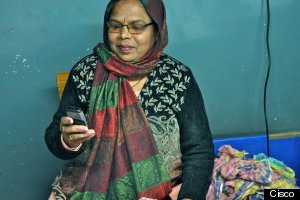Do you have a sewing machine? Do you have a blender?
These are not questions you would hear from a mortgage broker if you were trying to qualify for a home mortgage loan. But surprisingly, they are questions that give us insight into household wealth in countries like India and Peru.
I traveled with women's clothing brand Eileen Fisher to visit the people who make their scarves in India and their sweaters in Peru. One of the things the company is exploring, as part of their commitment to human rights and social consciousness, is whether workers earn enough to meet their basic needs, and if they are earning more every year, in real terms.
Previously, if you wanted to know how much workers earn and whether it's enough to feed their families or send their kids to school, you had to do in-depth research called a "market basket study" to collect data on the cost of food and other staples like fuel, housing, health care, and school fees. The process was expensive and could take up to a year.
Now all you do is ask 10 simple questions. The Progress Out of Poverty Index (PPI), developed by Grameen Foundation, uses household consumption habits as a proxy for economic development and assigns a poverty score based on the answers. Grameen's statisticians developed questions for 45 countries. So the questions in each country are different, but the scores are comparable across countries.

In India, the tool asks "Do you have a motorcycle?" "Do you have a mobile phone?" and "How many household members are 17 years old or younger?" In Peru, it asks "What is the material of the floors and walls of your house?" and "What's the highest education level of the female head of household?"
We partnered with Eileen Fisher to deliver these questions to hundreds of artisans and factory workers who make their clothes in Peru and India, and compared the data. Luna Lee, Human Rights Specialist at Eileen Fisher says, "We are excited to be able to hear from workers directly, and hope to use Labor Link as a tool to not only gather information, but to disseminate information that is relevant and important to workers."
The questions are so straightforward that they can be delivered on simple mobile phones (not smartphones) directly to workers. Our mobile platform, Labor Link, surveys workers anonymously in their local language - Spanish, Hindi, or Punjabi - and does not require literacy (unlike some SMS platforms).
What did we find? Twenty-two percent of the workers in India have a sewing machine at home. But it's not the individual questions that matter. It's all 10 questions together that determine likelihood of poverty. Comparing India to Peru, we found that the breakdown of workers in different income brackets -- high, medium, and low likelihood of poverty -- was similar across countries, but with slightly more income inequality in India.
Now that we have a baseline of data for both countries, we can track changes over time -- including gender differences -- and see if workers' lives are improving. In other words, as the name of the tool implies, are they making real progress out of poverty -- regardless of whether they have a sewing machine or a blender?
Good World Solutions is an official partner of Cisco, and helps to improve the economic livelihood of low-income workers in the developing world by leveraging technology solutions to provide access to critical information. Cisco's investment is supporting development and deployment of the Labor Link initiative, which gives low-income workers (particularly women) free information on wage and work-related issues, training, education, and financial literacy via mobile phones.